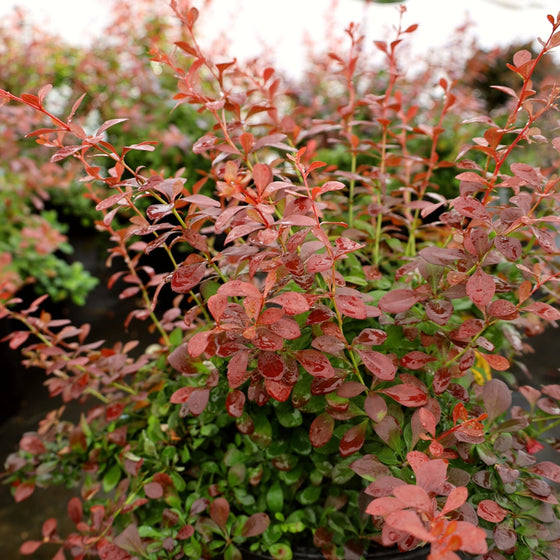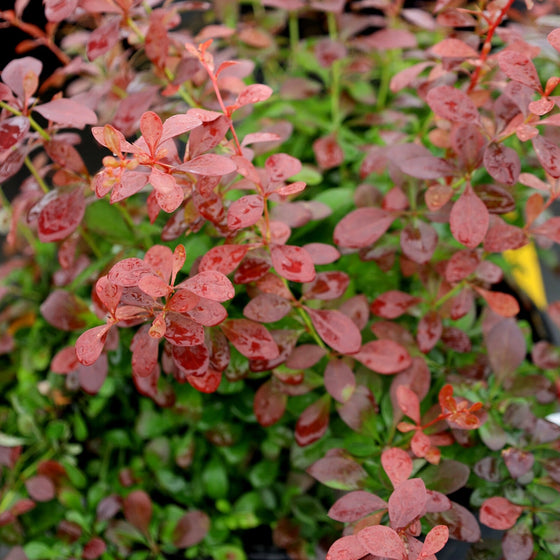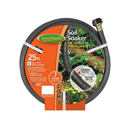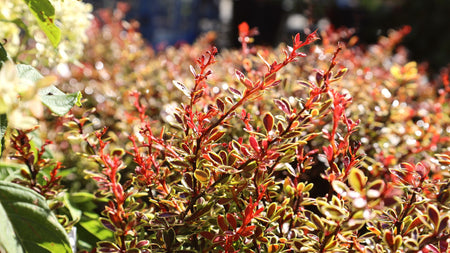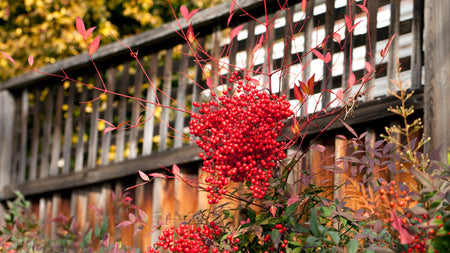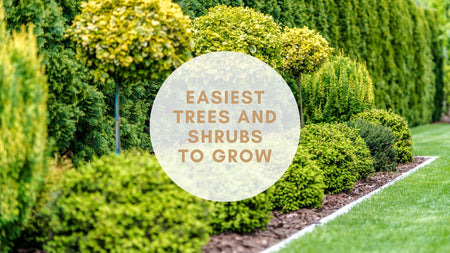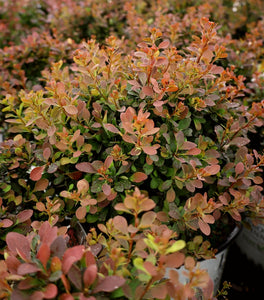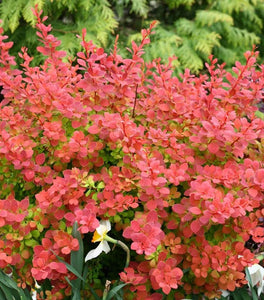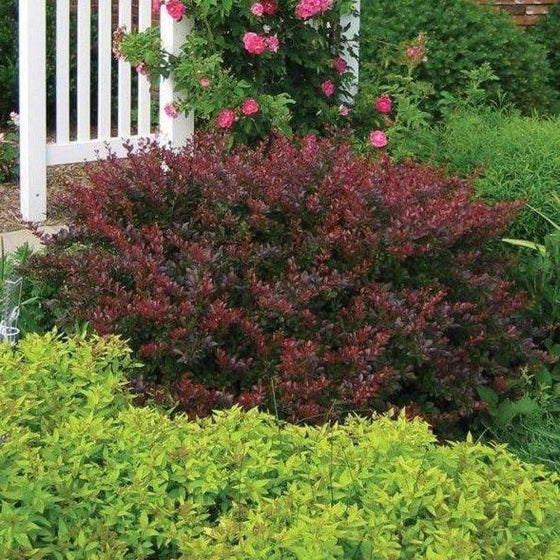
Images Depict Mature Plants
Crimson Pygmy Barberry Shrubs for Sale Online
The Crimson Pygmy Barberry is a stunning dwarf shrub that brings vibrant color and texture to any garden or landscape. With its deep red foliage that lasts throughout the growing season, this compact barberry is perfect for adding visual interest to borders, rock gardens, or as a low-maintenance hedge. Reaching a mature size of just 2-3 feet tall and wide, the Crimson Pygmy Barberry is an excellent choice for smaller gardens or tight spaces. Hardy in USDA Zones 4-8, it thrives in a variety of climates, offering beauty and structure to your outdoor spaces year-round.
This versatile shrub is prized for its striking color, resilience, and ease of care. The Crimson Pygmy Barberry prefers full sun to partial shade and adapts well to a wide range of soil types as long as the soil is well-drained. Once established, it is highly drought-tolerant, making it an excellent option for low-water gardens or xeriscaping. In the spring, small yellow flowers subtly contrast the rich red leaves, followed by bright red berries in the fall, offering multi-seasonal interest and a food source for birds.
Low-maintenance and durable, the Crimson Pygmy Barberry also features sharp thorns, which make it deer-resistant and helpful in creating natural barriers in the landscape. Its compact growth habit allows it to be easily shaped through pruning, perfect for maintaining a tidy appearance in foundation plantings or as an accent in mixed borders. With its stunning crimson foliage and easy-care nature, the Crimson Pygmy Barberry is an ideal choice for gardeners looking for a bold yet manageable shrub that adds color and texture throughout the seasons.
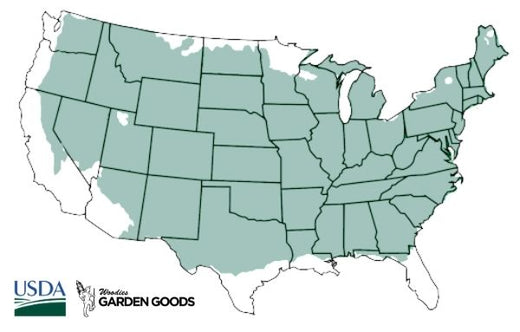
| Hardiness Zone: | 4-8 |
|---|---|
| Mature Height: | 2 to 3 Feet |
| Mature Width: | 2 to 3 Feet |
| Classification: | Broad leaved shrub |
| Sunlight: | Partial to full sun |
| Habit: | Rounded mounding habit |
| Foliage: | Deep red |
| Flower Color: | Inconspicuous |
| Pruning Season: | Best pruned in late winter before new growth emerges to maintain shape |
| Soil Condition: | Any well drained slightly acidic soil |
| Water Requirements: | Water well until established |
| Uses: | Full sun brings out the best foliage color; will adapt to drier sites |
How to Care for Crimson Pygmy Barberry
Before you buy a Crimson Pygmy Barberry Shrub, make sure to read about the care instructions that are recommended to keep this plant healthy and thriving.
How do I plant Crimson Pygmy Barberry Shrubs?
Planting Crimson Pygmy Barberry shrubs is a straightforward process that begins with selecting a location that receives full sun, as this helps the shrub develop its vibrant deep red foliage. These compact shrubs grow best in well-drained soil, so choose a spot that won’t retain excessive moisture. Dig a hole that is twice as wide and as deep as the root ball to give the roots room to spread. Place the shrub in the hole with the top of the root ball level with or slightly above the ground surface. After planting, backfill the hole with soil and water thoroughly to help the shrub establish itself. Space multiple shrubs about 2-3 feet apart if you’re planting a hedge or grouping them together in the landscape. Once planted, Crimson Pygmy Barberry shrubs require minimal maintenance to thrive. Add a 2-3 inch layer of mulch around the base of each shrub to help retain moisture, reduce weed growth, and regulate soil temperature. While these barberries are drought-tolerant once established, regular watering is necessary during the first growing season to help them develop a strong root system. These hardy shrubs are also deer-resistant and low-maintenance, making them an excellent choice for borders, foundation plantings, and erosion control. Properly planting and caring for your Crimson Pygmy Barberry ensures it will bring vibrant color and structure to your garden year-round.
How do I water Crimson Pygmy Barberry Shrubs?
Watering Crimson Pygmy Barberry shrubs properly is key to their health and vibrant foliage. During the first growing season, it’s important to water regularly, ensuring that the soil remains consistently moist but not waterlogged. Water deeply about once a week, allowing the moisture to reach the root zone. The goal is to establish a strong root system, so focus on watering at the base of the plant rather than using overhead sprinklers, which can encourage disease. If you’re planting the shrubs in a particularly hot or dry climate, you may need to increase the frequency of watering until the plants are established. Once Crimson Pygmy Barberry shrubs are established, they become highly drought-tolerant, requiring less frequent watering. However, during extended periods of drought or extreme heat, occasional deep watering will help maintain the shrub’s vibrant red foliage and overall health. A layer of mulch around the base of the shrub will also help retain moisture and reduce the need for frequent watering. Be sure to monitor the soil and water only when the top inch feels dry. Proper watering techniques will ensure your Crimson Pygmy Barberry thrives, adding long-lasting color and structure to your landscape.
How do I fertilize Crimson Pygmy Barberry Shrubs?
Fertilizing Crimson Pygmy Barberry shrubs helps promote healthy growth and enhances their vibrant red foliage. The best time to fertilize is in early spring, just as new growth begins to emerge. Use a balanced, slow-release fertilizer with a formula such as 10-10-10 or 14-14-14 to provide the necessary nutrients. Apply the fertilizer around the base of the shrub, keeping it a few inches away from the stems to prevent burning. Water the fertilizer in thoroughly to help it absorb into the soil and reach the roots. This early-season feeding will encourage strong growth throughout the growing season. For ongoing maintenance, you can apply another round of fertilizer in mid-summer to support the Crimson Pygmy Barberry’s continued growth and vibrant color. If you prefer organic options, compost or well-rotted manure can be worked into the soil around the base of the shrub to enrich the soil naturally. Be careful not to over-fertilize, as barberries typically require minimal feeding once established. By fertilizing properly, you’ll help ensure that your Crimson Pygmy Barberry shrubs thrive, maintaining their compact shape and adding colorful interest to your landscape year after year.

How do I Prune Crimson Pygmy Barberry?
Pruning Crimson Pygmy Barberry is essential for maintaining its compact shape and promoting healthy growth. The best time to prune is in early spring, just before new growth begins. Start by removing any dead, damaged, or diseased branches using clean, sharp pruning shears. This will improve air circulation within the shrub, reducing the risk of disease. Next, lightly trim the outer branches to maintain the desired shape and size of the shrub, especially if you’re using the Crimson Pygmy Barberry as a hedge or border plant. Be cautious not to remove too much at once, as this can stress the plant and reduce blooming. For more intensive shaping or size control, you can prune the Crimson Pygmy Barberry again in late summer or early fall. This shrub responds well to pruning, so it can be trimmed back by up to one-third of its size without harm. However, avoid pruning too late in the fall, as this may stimulate new growth that could be damaged by winter frost. Regular pruning not only helps keep the shrub looking tidy and attractive but also encourages dense, bushy growth, allowing the Crimson Pygmy Barberry to maintain its vibrant red foliage and neat form throughout the year.

